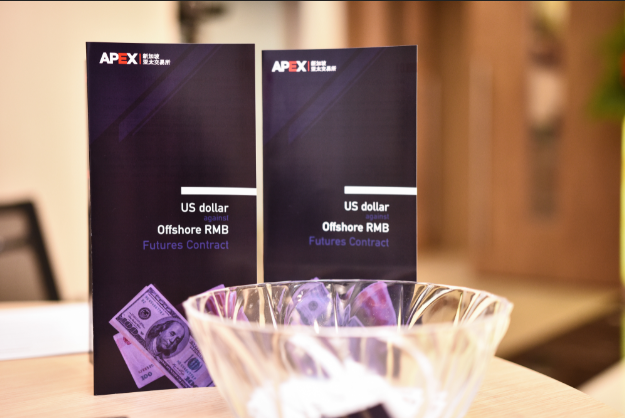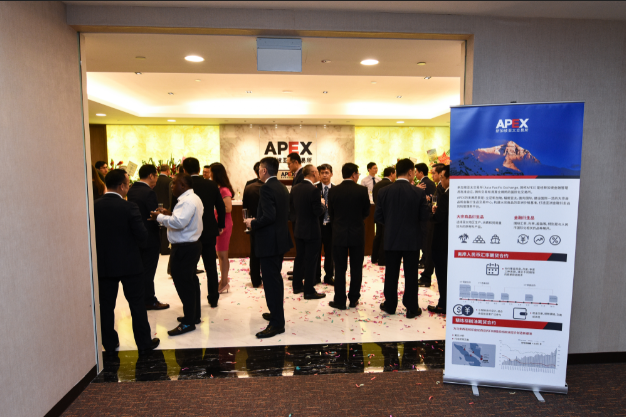Scan the QR code to add APEX on WeChat.

DISCLAIMER: It has come to our attention that there are individuals or organisations misrepresenting themselves to be an employee or agent of APEX or as APEX’s official group chat/channel on a social messaging application, purporting to engage in fund management and forex trading and requesting for investments.
Please note that these individuals or organisations are not employees or agents of, nor authorized by APEX, APEX does NOT engage in fund management or forex trading, and APEX will NOT ask for direct investment of funds. Trading access to APEX is currently only through our members, whose membership details can be found at https://www.asiapacificex.com/trade/trading-members.
Apex Us Dollar Against Offshore Renminbi Futures Contract Listed For Trading: Three Major Features

1) Launch of UC Contract
On 19th October 2018, 9am Singapore time, Asia Pacific Exchange (APEX) officially launched the USD/CNH (offshore RMB) Futures Contract (Contract Code: UC) for trading. The listing ceremony was graced by our Clearing members, bank representatives, corporate partners and other distinguished guests.
On the first day of trading, the most active contract is UC1811W1. As of 10:17 AM, the contract traded at a high of CNH6.9517/USD, and a low of CNH6.9447/USD. The total traded volume was 182, the total turnover is 1,820,000USD.
With the acceleration of the internationalization of the RMB, the international status of the RMB has been on the rise. On 1 October 2016, the RMB became the first emerging market currency to be included in the IMF’s special drawing rights (SDR) basket, becoming one of global reserve currencies together with US Dollar, Euro, Pound and Japanese Yen. Currently, more than 60 countries and territories had already begun to use RMB as an alternative reserve currency. The RMB is now widely used in global trade and investment.
The pace of reform of the RMB exchange rate regime is gaining momentum with greater international trade flows, resulting in trends of higher volatility and increased fluctuation in both directions of the exchange rate. Hence, the demand for a hedging instrument for companies and investors to manage their RMB exposure is increasing.
The RMB circulating outside China mainland becomes offshore RMB, with largest deposit centres located in Hong Kong, Singapore, Taiwan and London. Based on BIS Trienniel Survey of foreign exchange and OTC derivatives trading, offshore RMB OTC transaction value had increased from an average daily value (ADV) of USD 86 billion in 2013 to USD147 billion in 2016.
In the exchange traded space, the absolute value is relatively lower, but the growth rate is much faster. The ADV has grown from US$48 million in 2013 to US$322 million in 2016 and further to US$2.5 billion in 2018.
APEX UC contract differentiates itself with three major features for new business opportunities.
2) APEX UC Contract: Three major features
Firstly, in addition to the conventional monthly and quarterly tenors, the contract covers near term tenors through its weekly contracts. As the world’s first weekly USD/CNH Contract, APEX UC Contract series include “4 near-term consecutive weekly Contracts followed by 3 consecutive monthly Contracts and 3 consecutive quarterly Contracts”, on a rolling basis.
The weekly contract introduces the most popular OTC market tenor into the exchange-traded space, and will offer market participants the flexibility to manage their short and long-term RMB exposure.
Secondly, APEX UC Contract have a face value of US$ 10,000 per lot. The small contract size enables market participants to manage their RMB exposure more precisely, thereby better managing tail risks. The small contract size is also expected to attract a more diverse pool of market participants with different investment and hedging needs.
Thirdly, the use of cash settlement is efficient and convenient for market participants. The contract’s final settlement price is based on the USD/CNY (HK) Spot Rate published by the Treasury Markets Association of Hong Kong (TMA), the authoritative pricing benchmark for the spot exchange rate between USD and offshore RMB. On the last trading day, customers only need to settle their expiring positions’ profit and loss without the need to swap the face value of the contract, hence increasing their capital efficiencies.

3) Updates on APEX first product: APEX RBD Palm Olein Futures
Since APEX’s inaugural launch on 25th May 2018, its first product, the APEX RBD Palm Olein Futures Contract, has gained significant traction among market participants. We have seen increasing involvement from commercial clients, which has resulted in a steady increase in APEX Palm Olein Futures Contracts’ open interest. The trading prices of the APEX Palm Olein Futures Contracts are now highly correlated with the prices of similar OTC and exchange-traded palm oil and palm olein contracts and the FOB paper market, a sign that it is achieving its price discovery function.
APEX has a diversified and multi-level clientele base, including various manufacturer, producers, traders, financial institutions, professional investment funds and individual customers, forming a comprehensive market ecosystem.
For physical delivery of its Palm Olein Contract, APEX has adopted a challenging, but the most effective FOB physical delivery method. The designated delivery ports are located on both sides of the Straits of Malacca, including Malaysia’s Port Klang and Pasir Gudang, and Indonesia’s Dumai and Belawan ports. They are the most important ports for palm olein exports, as they are near the main palm oil production areas. Facilities at the ports are ideal, with the palm oil processing plant and storage tanks surrounding the harbour.
4) APEX: Moving forward
APEX aims to achieve a series of important functions such as price discovery and risk management. Following the smooth trading of the Palm Olein Contract and the successful launch of the UC contract, APEX will subsequently introduce other derivative contracts, ranging from agricultural, energy, metals, FX, Interest rate and stock indexes to provide a comprehensive suite of products. Ultimately, APEX aims to offer a diverse range of products and services to serve all types of clienteles, and to support the continued rise of the Asian economy.
Currently, the real time market data of APEX Contracts can be retrieved through data terminals such as Thomson Reuters, Bloomberg, WIND Financial Terminal, AdvisorXs, Esunny, myTrader (Wenhua) and Pobo5. The APEX official website www.asiapacificex.com also provides real-time quotes.




